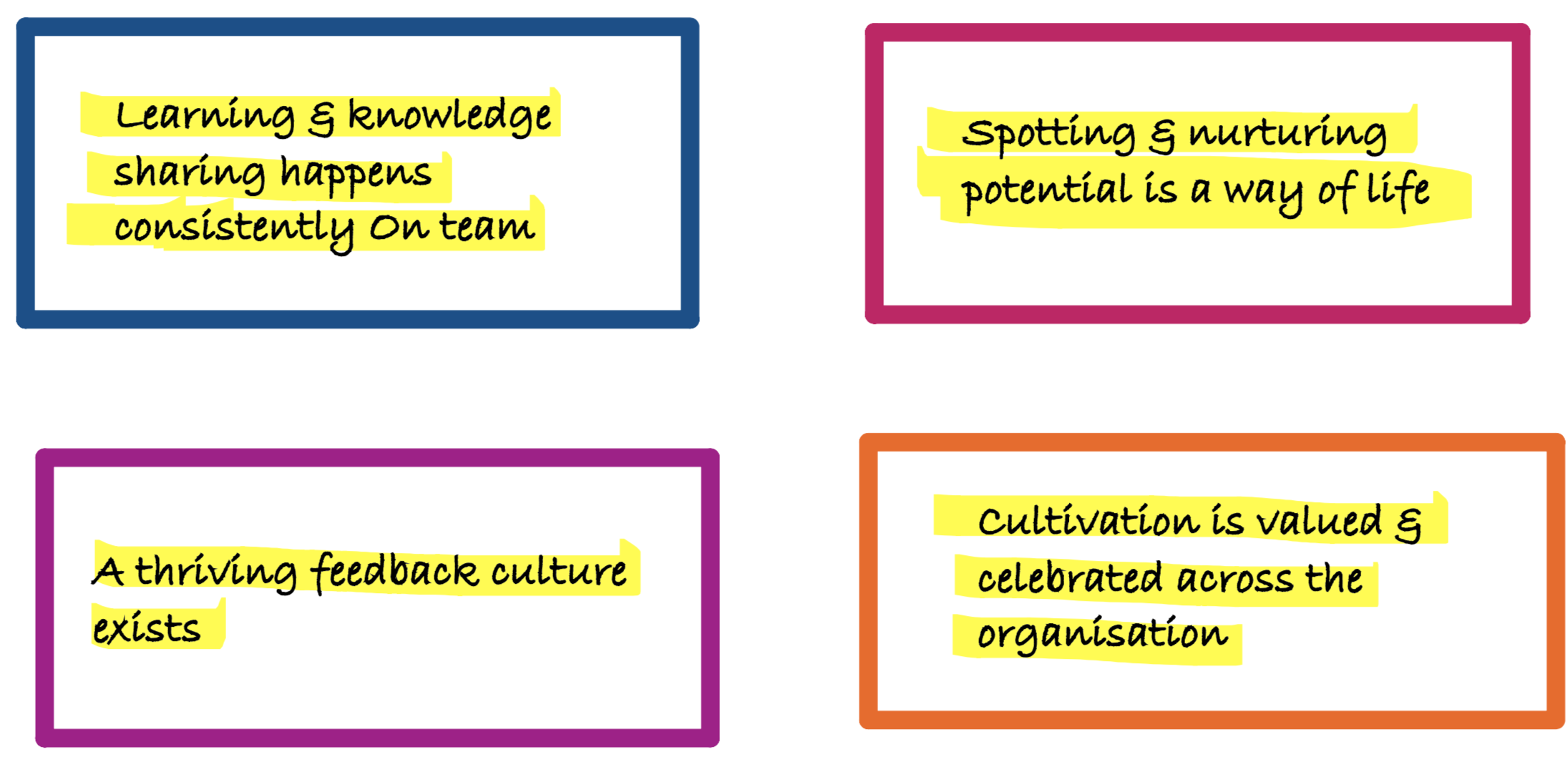What a Cultivation Culture looks like
4 Key Outcomes of the Cultivation Culture Program Framework at ThoughtWorks

ThoughtWorkers are known to hold strong opinions & have the courage to voice them as well. Impassioned discussions and feverish debates are a way of life for us. Give us any topic - Test driven development or climate change, naming a meeting room or organising Mafia night- we are game to slice & dice it, explore multiple perspectives & fight intellectual battles with each other until we finally converge. We are just incorrigibly curious and passionate that way!
There is one subject in particular, which without fail, evokes the most intense conversations of all - our culture.
ThoughtWorkers hold their culture with the fierceness of a warrior & the steadfastness of a custodian.
We’ve experienced this first hand since we’ve joined ThoughtWorks and we know through stories passed down to us that it’s always been this way.
This culture that we cherish so much, was based on the foundations laid out in our early years & evolved organically for the most part from there. In recent years, as we have grown, we realised that we need to become more intentional about not just keeping the best parts of our culture alive but also evolving it for the future.
The concept of cultivation culture was introduced in a reflective blog post by our CEO Guo Xiao a few years ago. As a company, we’ve gradually been exploring this idea and making sense of it. In 2018, we at ThoughtWorks India decided to invest a dedicated effort to strengthen our culture of cultivation. This is when we conceptualised the Cultivation Program, which we’ve been running & evolving since then.
In this post, we’ll share what according to us are the key components of a cultivation culture. We’ve discussed why we believe in strengthening our cultivation culture in a previous article here.
The Vision
As our north star, we feel this statement summarises clearly what we've envisioned:
“Create an ecosystem where every ThoughtWorker takes pride in growing others.”
The 4 Key Components of Cultivation Culture
There are 4 main components, that need to be strengthened within an organisation for a culture of cultivation to flourish. We've illustrated what a strong cultivation culture would look and feel like and with ThoughtWorks as our context. You can also see these components as outcomes you should aim to create if you want to build such a culture.

To begin with, do bear the following in mind:
- We’ve articulated the first three components to be primarily team focused - meaning that we are looking to create these outcomes within teams. They can, are & will be visible in larger communities as well, focus should be on creating them within teams.
- The components illustrate practices & mindsets that already exist at ThoughtWorks, our aim is not to introduce something entirely new, but to focus on strengthening these aspects of our culture.
I. Learning & Knowledge sharing happens consistently on teams
We want an environment where teams are constantly learning together & elevating their collective capabilities. They continuously share their experience, insights, knowledge and skills with each other about how to do things better. Team members are aware of what their strengths are & they leverage them to help others get better in these areas as well. Likewise, they are aware of their gaps, and have abundant opportunities to learn from others within the team. Learning from & with each other is the default mode in which teams operate. There are frequent & rich team rituals in place that support this environment.
The key thing to remember here is that learning is not focused entirely on the self. In fact it is primarily centred on “the other”. The main stance here is that “I learn by helping others learn”.
So team members proactively find ways to help other members learn through means that may be formal or informal, structured or unstructured. Examples range from team lunch & learns, lightning talks, pairing, learning & skill matrices to creative rituals teams craft themselves.
While learning & knowledge sharing extends beyond teams in reality & continues to happen through internal & external community rituals, our focus in the cultivation program is on realising this outcome within teams.
II. Spotting & Nurturing Potential is a way of life
This outcome places primary responsibility on team leads (folks who are acting in lead capacity in the team, irrespective of title/grade/role). Do keep in mind that we are not suggesting a hierarchical lead:member relationship with a one on one mapping. One team could have 2 to 3 people acting in lead capacity in the team. For example, on a ThoughtWorks software development team, it's common for the Tech Lead, Business Analyst and the Project Manager together form the leadership in the team. The primary responsibility of realising this outcome lies with them as a group. However, it goes without saying that all team members can & should contribute to this outcome by spotting & nurturing potential in each other.
There are two fundamental stances here:
Strengths based mindset - “People are at their best when they can utilise their strengths at work rather than focus on their weaknesses.” This doesn’t imply that you needn’t invest in improving gaps/weaknesses. It simply suggests that it’s best to be focused on using strengths most of the time.
Growth based mindset - “Everyone has potential that can & should be developed intentionally, in line with one’s aspirations, resulting in growth.”
We want a culture where leaders own the development of their team members as one of their most important responsibilities. They keenly look for strengths & talents in their team members and then invest in helping them develop those. They could do this through mentoring & coaching or through finding the right opportunities for their team members to develop specific skills. The opportunities could range from one time events like giving a conference talk, hosting an event or leading a client call to longer term ones like a 6 month assignment or a new role/responsibility within the team. The main idea is that team development assumes a significant role in any leaders’ psyche. They focus on their team’s development at least as much as they do on delivery.
III. A thriving feedback culture exists
Feedback is one of the five values of Extreme Programming. So it’s no surprise that we’ve always had a deep conviction in the power & value of feedback. We want an environment where feedback is given & sought frequently, and with high quality. Teams build enough psychological safety to share open & honest feedback with each other. While strong & structured rituals for sharing feedback exist, event based feedback is shared as a way of life on a daily basis. Team members constantly reinforce strengths & help others improve through feedback. They also continuously work to improve their own capability to share & receive feedback.
The fundamental stance here is that “Feedback is a powerful tool to foster growth, for oneself & others ”.
IV. Cultivation is valued & celebrated across the organisation
At ThoughtWorks, given our collaboration & competence centric nature, we’ve always celebrated people who are great influencers, networkers & craftspersons. To strengthen the culture of cultivation, we want to celebrate people who are great at cultivation, with equal fervour. We want to tell & hear more stories of transformation & growth through cultivation. We want to build conviction about the value & power of cultivation in our collective psyche as an organisation.
The fundamental stance here is that “Cultivation should be an expected norm & a valued contribution in the system.”
This outcome does have a more systemic focus and goes beyond teams, since it requires integration at an organisational & functional level. For instance, when we look to place people in leadership roles, we want to place high value on their ability to cultivate others. Or when we hire new people, we want to have cultivation related conversations with them. But depending on your role / responsibility, you can act on this outcome in your context & within your teams. For example, as a team you can make it a practice to call out those who have helped others learn in your project retros.
These 4 outcomes are meant to paint a clear picture of what our world would be like when we achieve our vision. Like everything we do at ThoughtWorks, as we learn more, we will keep evolving them.
You can read about How to Build a Cultivation Culture in another article.
Acknowledgement: Akshay Dhavle from ThoughtWorks was our collaborator for the overall Cultivation Program Design.
Cover image credit: David Pisnoy at Unsplash
4 key components illustration: by Our Culture Cafe




